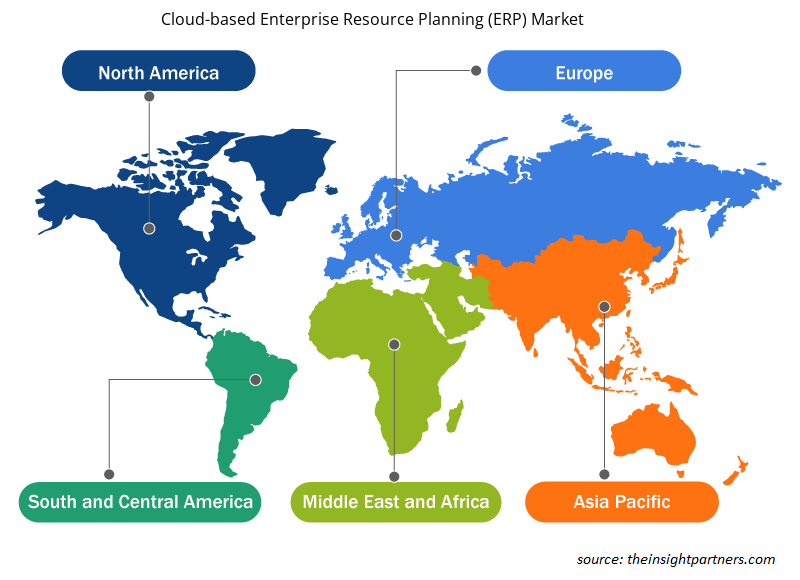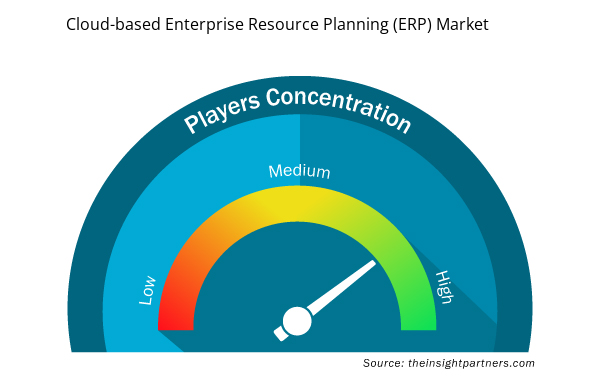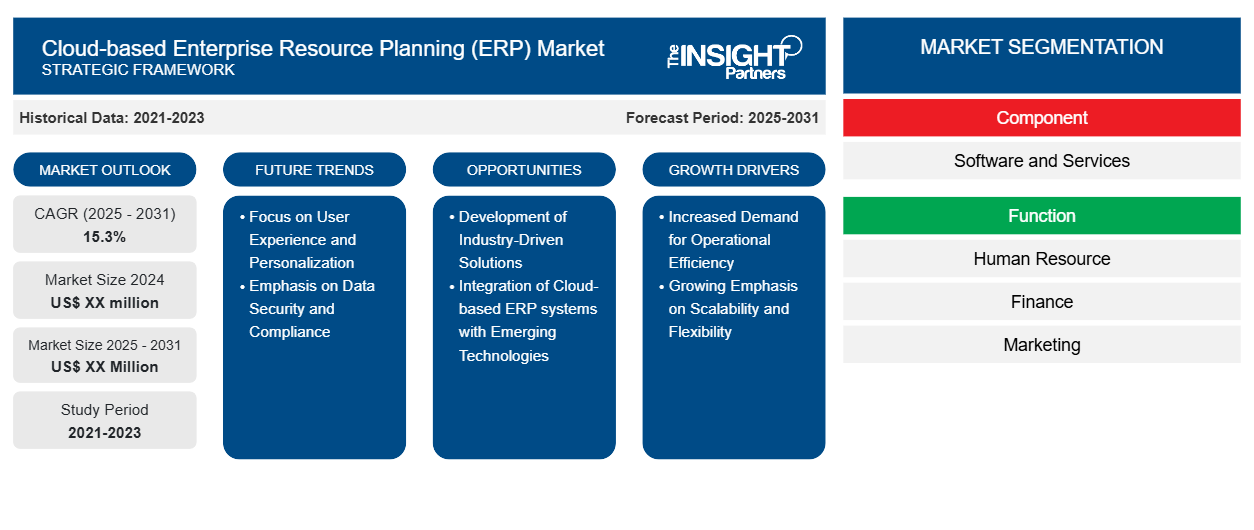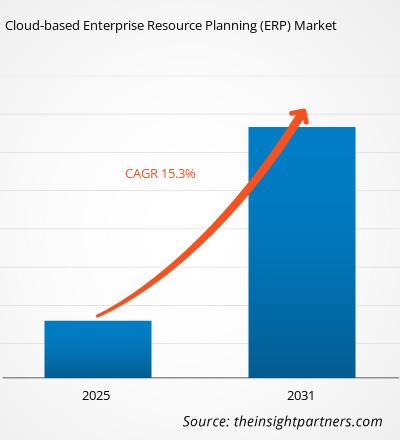من المتوقع أن يسجل سوق تخطيط موارد المؤسسة المستند إلى السحابة (ERP) معدل نمو سنوي مركب بنسبة 15.3٪ من عام 2023 إلى عام 2031، مع توسع حجم السوق من XX مليون دولار أمريكي في عام 2023 إلى XX مليون دولار أمريكي بحلول عام 2031.
تم تقسيم التقرير حسب المكون (البرمجيات والخدمات)؛ والوظيفة (الموارد البشرية والمالية والتسويق)؛ والصناعة (التصنيع، والخدمات المصرفية والمالية والتأمين، والتجزئة، والحكومة، والفضاء والدفاع، والتعليم، وتكنولوجيا المعلومات والاتصالات، والرعاية الصحية). كما تم تقسيم التحليل العالمي إلى أجزاء على المستوى الإقليمي والدول الرئيسية. ويقدم التقرير القيمة بالدولار الأمريكي للتحليل والأجزاء المذكورة أعلاه
غرض التقرير
يهدف تقرير سوق تخطيط موارد المؤسسات المستند إلى السحابة (ERP) الصادر عن The Insight Partners إلى وصف المشهد الحالي والنمو المستقبلي وأهم العوامل الدافعة والتحديات والفرص. سيوفر هذا رؤى لمختلف أصحاب المصلحة في الأعمال التجارية، مثل:
- مزودي/مصنعي التكنولوجيا: لفهم ديناميكيات السوق المتطورة ومعرفة فرص النمو المحتملة، وتمكينهم من اتخاذ قرارات استراتيجية مستنيرة.
- المستثمرون: إجراء تحليل شامل للاتجاهات فيما يتعلق بمعدل نمو السوق، وتوقعات السوق المالية، والفرص المتاحة عبر سلسلة القيمة.
- الهيئات التنظيمية: لتنظيم السياسات ومراقبة الأنشطة في السوق بهدف تقليل الانتهاكات والحفاظ على ثقة المستثمرين ودعم سلامة السوق واستقرارها.
تجزئة سوق تخطيط موارد المؤسسات المستند إلى السحابة (ERP)
عنصر
- البرمجيات والخدمات
وظيفة
- الموارد البشرية
- تمويل
- تسويق
صناعة
- تصنيع
- الخدمات المالية والمصرفية والتأمين
- بيع بالتجزئة
- حكومة
- الفضاء والدفاع
- تعليم
- تكنولوجيا المعلومات والاتصالات
- الرعاية الصحية
الجغرافيا
- أمريكا الشمالية
- أوروبا
- آسيا والمحيط الهادئ
- أمريكا الجنوبية والوسطى
- الشرق الأوسط وأفريقيا
الجغرافيا
- أمريكا الشمالية
- أوروبا
- آسيا والمحيط الهادئ
- أمريكا الجنوبية والوسطى
- الشرق الأوسط وأفريقيا
قم بتخصيص هذا التقرير ليناسب متطلباتك
ستحصل على تخصيص لأي تقرير - مجانًا - بما في ذلك أجزاء من هذا التقرير، أو تحليل على مستوى الدولة، وحزمة بيانات Excel، بالإضافة إلى الاستفادة من العروض والخصومات الرائعة للشركات الناشئة والجامعات
- احصل على أهم اتجاهات السوق الرئيسية لهذا التقرير.ستتضمن هذه العينة المجانية تحليلاً للبيانات، بدءًا من اتجاهات السوق وحتى التقديرات والتوقعات.
محركات نمو سوق تخطيط موارد المؤسسات المستند إلى السحابة (ERP)
- زيادة الطلب على الكفاءة التشغيلية: تبحث الشركات باستمرار عن طرق لتحسين كفاءتها التشغيلية وخفض التكاليف. توفر أنظمة تخطيط موارد المؤسسات المستندة إلى السحابة منصة مركزية لإدارة وظائف الأعمال المختلفة مثل التمويل والموارد البشرية وسلسلة التوريد وإدارة علاقات العملاء. من خلال أتمتة العمليات وتحسين إمكانية الوصول إلى البيانات، يمكن للمؤسسات تبسيط العمليات وتقليل الأخطاء اليدوية وتعزيز التعاون بين الإدارات. يعد هذا الدافع نحو الكفاءة عاملاً رئيسيًا يدفع إلى اعتماد حلول تخطيط موارد المؤسسات المستندة إلى السحابة.
- التركيز المتزايد على قابلية التوسع والمرونة: إحدى المزايا الرئيسية لأنظمة تخطيط موارد المؤسسات المستندة إلى السحابة هي قابلية التوسع والمرونة، والتي تعد أمرًا بالغ الأهمية للشركات المتنامية. يمكن للشركات توسيع حلول تخطيط موارد المؤسسات الخاصة بها بسهولة وفقًا لاحتياجاتها المحددة دون الحاجة إلى استثمارات أولية كبيرة في البنية الأساسية. تتيح هذه القدرة على التكيف للمؤسسات الاستجابة بسرعة لظروف السوق المتغيرة ومتطلبات الأعمال. مع إعطاء الشركات الأولوية بشكل متزايد للرشاقة في عملياتها، يتزايد الطلب على أنظمة تخطيط موارد المؤسسات المستندة إلى السحابة التي توفر قابلية التوسع والتخصيص بشكل مطرد.
الاتجاهات المستقبلية لسوق تخطيط موارد المؤسسات المستند إلى السحابة (ERP)
- التركيز على تجربة المستخدم والتخصيص: مع تحول تجربة المستخدم إلى عامل حاسم في تبني البرمجيات، هناك اتجاه متزايد نحو تعزيز قابلية الاستخدام والتخصيص لأنظمة تخطيط موارد المؤسسات المستندة إلى السحابة. يعطي المزودون الأولوية للواجهات البديهية ولوحات المعلومات القابلة للتخصيص والوظائف المصممة خصيصًا لتلبية الاحتياجات المحددة للمستخدمين المختلفين داخل المؤسسة. هذا التركيز على تجربة المستخدم لا يشجع على ارتفاع معدلات التبني فحسب، بل ويمكّن الموظفين أيضًا من الاستفادة من أنظمة تخطيط موارد المؤسسات بشكل أكثر فعالية، مما يؤدي إلى تحسين الإنتاجية والرضا.
- التركيز على أمن البيانات والامتثال: مع تزايد كمية البيانات الحساسة التي تتم معالجتها من خلال أنظمة تخطيط موارد المؤسسات المستندة إلى السحابة، أصبح أمن البيانات والامتثال التنظيمي من الشواغل الرئيسية. أصبحت المؤسسات أكثر يقظة بشأن حماية بياناتها وضمان الامتثال للوائح مثل GDPR وCCPA. يستجيب مزودو Cloud ERP لهذا الاتجاه من خلال تنفيذ تدابير أمنية قوية، بما في ذلك التشفير والمصادقة متعددة العوامل والتدقيق الأمني المنتظم. يعد هذا التركيز على حماية البيانات أمرًا بالغ الأهمية لبناء الثقة مع العملاء وضمان استمرارية الأعمال.
فرص سوق تخطيط موارد المؤسسات المستندة إلى السحابة (ERP)
- تطوير حلول موجهة نحو الصناعة: نظرًا لأن الشركات في مختلف الصناعات تواجه تحديات ومتطلبات فريدة، فهناك فرصة متزايدة لمقدمي خدمات تخطيط موارد المؤسسات المستندة إلى السحابة لتطوير حلول خاصة بالصناعة. من خلال تقديم وظائف وميزات مخصصة تلبي احتياجات قطاعات محددة - مثل التصنيع أو الرعاية الصحية أو البيع بالتجزئة أو البناء - يمكن لمقدمي الخدمات التمييز بين أنفسهم في سوق مزدحمة. يمكن أن يؤدي هذا التخصص إلى زيادة رضا العملاء وولائهم، حيث من المرجح أن تختار المؤسسات حلول تخطيط موارد المؤسسات التي تتوافق بشكل وثيق مع احتياجاتها التشغيلية.
- دمج أنظمة تخطيط موارد المؤسسات القائمة على السحابة مع التقنيات الناشئة: إن إمكانية دمج أنظمة تخطيط موارد المؤسسات القائمة على السحابة مع التقنيات الناشئة مثل إنترنت الأشياء (IoT) والبلوك تشين والتحليلات المتقدمة تقدم فرصة كبيرة للابتكار. ومن خلال دمج هذه التقنيات، يمكن لأنظمة تخطيط موارد المؤسسات القائمة على السحابة تعزيز الرؤية وتحسين إدارة سلسلة التوريد وتوفير رؤى في الوقت الفعلي لأداء الأعمال. ومع سعي المؤسسات إلى تسخير قوة هذه التقنيات، فإن مزودي أنظمة تخطيط موارد المؤسسات القائمة على السحابة الذين يقدمون قدرات التكامل السلس سيكونون في وضع جيد لاستقطاب عملاء جدد ودفع النمو على المدى الطويل.
رؤى إقليمية حول سوق تخطيط موارد المؤسسات المستند إلى السحابة (ERP)
لقد قام المحللون في Insight Partners بشرح الاتجاهات والعوامل الإقليمية المؤثرة على سوق تخطيط موارد المؤسسات المستند إلى السحابة (ERP) طوال فترة التنبؤ بشكل شامل. يناقش هذا القسم أيضًا قطاعات سوق تخطيط موارد المؤسسات المستند إلى السحابة (ERP) والجغرافيا في جميع أنحاء أمريكا الشمالية وأوروبا ومنطقة آسيا والمحيط الهادئ والشرق الأوسط وأفريقيا وأمريكا الجنوبية والوسطى.

- احصل على البيانات الإقليمية المحددة لسوق تخطيط موارد المؤسسات المستندة إلى السحابة (ERP)
نطاق تقرير سوق تخطيط موارد المؤسسات المستند إلى السحابة (ERP)
| سمة التقرير | تفاصيل |
|---|---|
| حجم السوق في عام 2023 | XX مليون دولار أمريكي |
| حجم السوق بحلول عام 2031 | XX مليون دولار أمريكي |
| معدل النمو السنوي المركب العالمي (2023 - 2031) | 15.3% |
| البيانات التاريخية | 2021-2022 |
| فترة التنبؤ | 2024-2031 |
| القطاعات المغطاة | حسب المكون
|
| المناطق والدول المغطاة | أمريكا الشمالية
|
| قادة السوق وملفات تعريف الشركات الرئيسية |
|
كثافة اللاعبين في سوق تخطيط موارد المؤسسات المستند إلى السحابة (ERP): فهم تأثيرها على ديناميكيات الأعمال
يشهد سوق تخطيط موارد المؤسسات المستند إلى السحابة نموًا سريعًا، مدفوعًا بالطلب المتزايد من المستخدم النهائي بسبب عوامل مثل تفضيلات المستهلكين المتطورة والتقدم التكنولوجي والوعي الأكبر بفوائد المنتج. ومع ارتفاع الطلب، تعمل الشركات على توسيع عروضها والابتكار لتلبية احتياجات المستهلكين والاستفادة من الاتجاهات الناشئة، مما يؤدي إلى زيادة نمو السوق.
تشير كثافة اللاعبين في السوق إلى توزيع الشركات أو المؤسسات العاملة في سوق أو صناعة معينة. وهي تشير إلى عدد المنافسين (اللاعبين في السوق) الموجودين في مساحة سوق معينة نسبة إلى حجمها أو قيمتها السوقية الإجمالية.
الشركات الرئيسية العاملة في سوق تخطيط موارد المؤسسات المستندة إلى السحابة (ERP) هي:
- ساب اس اي
- شركة مايكروسوفت
- شركة أوراكل
- شركة إبيكور للبرمجيات
- القوة المالية.كوم
إخلاء المسؤولية : الشركات المذكورة أعلاه ليست مرتبة بأي ترتيب معين.

- احصل على نظرة عامة على أهم اللاعبين الرئيسيين في سوق تخطيط موارد المؤسسات المستند إلى السحابة (ERP)
نقاط البيع الرئيسية
- التغطية الشاملة: يغطي التقرير بشكل شامل تحليل المنتجات والخدمات والأنواع والمستخدمين النهائيين لسوق تخطيط موارد المؤسسة المستندة إلى السحابة (ERP)، مما يوفر صورة شاملة.
- تحليل الخبراء: تم تجميع التقرير على أساس الفهم العميق لخبراء الصناعة والمحللين.
- معلومات محدثة: يضمن التقرير أهمية الأعمال التجارية بسبب تغطيته للمعلومات الحديثة واتجاهات البيانات.
- خيارات التخصيص: يمكن تخصيص هذا التقرير لتلبية متطلبات العملاء المحددة وبما يتناسب مع استراتيجيات العمل بشكل مناسب.
وبالتالي، يمكن أن يساعد تقرير البحث حول سوق تخطيط موارد المؤسسات المستند إلى السحابة (ERP) في تمهيد الطريق لفك شفرة وفهم سيناريو الصناعة وآفاق النمو. ورغم وجود بعض المخاوف المشروعة، فإن الفوائد الإجمالية لهذا التقرير تميل إلى التفوق على العيوب.
- التحليل التاريخي (سنتان)، السنة الأساسية، التوقعات (7 سنوات) مع معدل النمو السنوي المركب
- تحليل PEST و SWOT
- حجم السوق والقيمة / الحجم - عالميًا وإقليميًا وقطريًا
- الصناعة والمنافسة
- مجموعة بيانات Excel



Report Coverage
Revenue forecast, Company Analysis, Industry landscape, Growth factors, and Trends

Segment Covered
This text is related
to segments covered.

Regional Scope
North America, Europe, Asia Pacific, Middle East & Africa, South & Central America

Country Scope
This text is related
to country scope.
الأسئلة الشائعة
Some of the customization options available based on the request are an additional 3-5 company profiles and country-specific analysis of 3-5 countries of your choice. Customizations are to be requested/discussed before making final order confirmation# as our team would review the same and check the feasibility
The report can be delivered in PDF/PPT format; we can also share excel dataset based on the request
Digital transformation initiatives and significant in cost efficiency and scalability are the major factors driving the cloud-based Enterprise Resource Planning (ERP) market
Adoption of Industry-Specific ERP solutions to play a significant role in the global cloud-based Enterprise Resource Planning (ERP) market in the coming years
The Cloud-Based Enterprise Resource Planning (ERP) Market is estimated to witness a CAGR of 15.3% from 2023 to 2031
Trends and growth analysis reports related to Technology, Media and Telecommunications : READ MORE..
1. SAP SE
2. Microsoft Corporation
3. Oracle Corporation
4. Epicor Software Corporation
5. Financialforce.Com
6. Plex Systems, Inc.
7. Infor
8. Sage Software, Inc.
9. Intacct Corporation
10. Ramco Systems
The Insight Partners performs research in 4 major stages: Data Collection & Secondary Research, Primary Research, Data Analysis and Data Triangulation & Final Review.
- Data Collection and Secondary Research:
As a market research and consulting firm operating from a decade, we have published and advised several client across the globe. First step for any study will start with an assessment of currently available data and insights from existing reports. Further, historical and current market information is collected from Investor Presentations, Annual Reports, SEC Filings, etc., and other information related to company’s performance and market positioning are gathered from Paid Databases (Factiva, Hoovers, and Reuters) and various other publications available in public domain.
Several associations trade associates, technical forums, institutes, societies and organization are accessed to gain technical as well as market related insights through their publications such as research papers, blogs and press releases related to the studies are referred to get cues about the market. Further, white papers, journals, magazines, and other news articles published in last 3 years are scrutinized and analyzed to understand the current market trends.
- Primary Research:
The primarily interview analysis comprise of data obtained from industry participants interview and answers to survey questions gathered by in-house primary team.
For primary research, interviews are conducted with industry experts/CEOs/Marketing Managers/VPs/Subject Matter Experts from both demand and supply side to get a 360-degree view of the market. The primary team conducts several interviews based on the complexity of the markets to understand the various market trends and dynamics which makes research more credible and precise.
A typical research interview fulfils the following functions:
- Provides first-hand information on the market size, market trends, growth trends, competitive landscape, and outlook
- Validates and strengthens in-house secondary research findings
- Develops the analysis team’s expertise and market understanding
Primary research involves email interactions and telephone interviews for each market, category, segment, and sub-segment across geographies. The participants who typically take part in such a process include, but are not limited to:
- Industry participants: VPs, business development managers, market intelligence managers and national sales managers
- Outside experts: Valuation experts, research analysts and key opinion leaders specializing in the electronics and semiconductor industry.
Below is the breakup of our primary respondents by company, designation, and region:

Once we receive the confirmation from primary research sources or primary respondents, we finalize the base year market estimation and forecast the data as per the macroeconomic and microeconomic factors assessed during data collection.
- Data Analysis:
Once data is validated through both secondary as well as primary respondents, we finalize the market estimations by hypothesis formulation and factor analysis at regional and country level.
- Macro-Economic Factor Analysis:
We analyse macroeconomic indicators such the gross domestic product (GDP), increase in the demand for goods and services across industries, technological advancement, regional economic growth, governmental policies, the influence of COVID-19, PEST analysis, and other aspects. This analysis aids in setting benchmarks for various nations/regions and approximating market splits. Additionally, the general trend of the aforementioned components aid in determining the market's development possibilities.
- Country Level Data:
Various factors that are especially aligned to the country are taken into account to determine the market size for a certain area and country, including the presence of vendors, such as headquarters and offices, the country's GDP, demand patterns, and industry growth. To comprehend the market dynamics for the nation, a number of growth variables, inhibitors, application areas, and current market trends are researched. The aforementioned elements aid in determining the country's overall market's growth potential.
- Company Profile:
The “Table of Contents” is formulated by listing and analyzing more than 25 - 30 companies operating in the market ecosystem across geographies. However, we profile only 10 companies as a standard practice in our syndicate reports. These 10 companies comprise leading, emerging, and regional players. Nonetheless, our analysis is not restricted to the 10 listed companies, we also analyze other companies present in the market to develop a holistic view and understand the prevailing trends. The “Company Profiles” section in the report covers key facts, business description, products & services, financial information, SWOT analysis, and key developments. The financial information presented is extracted from the annual reports and official documents of the publicly listed companies. Upon collecting the information for the sections of respective companies, we verify them via various primary sources and then compile the data in respective company profiles. The company level information helps us in deriving the base number as well as in forecasting the market size.
- Developing Base Number:
Aggregation of sales statistics (2020-2022) and macro-economic factor, and other secondary and primary research insights are utilized to arrive at base number and related market shares for 2022. The data gaps are identified in this step and relevant market data is analyzed, collected from paid primary interviews or databases. On finalizing the base year market size, forecasts are developed on the basis of macro-economic, industry and market growth factors and company level analysis.
- Data Triangulation and Final Review:
The market findings and base year market size calculations are validated from supply as well as demand side. Demand side validations are based on macro-economic factor analysis and benchmarks for respective regions and countries. In case of supply side validations, revenues of major companies are estimated (in case not available) based on industry benchmark, approximate number of employees, product portfolio, and primary interviews revenues are gathered. Further revenue from target product/service segment is assessed to avoid overshooting of market statistics. In case of heavy deviations between supply and demand side values, all thes steps are repeated to achieve synchronization.
We follow an iterative model, wherein we share our research findings with Subject Matter Experts (SME’s) and Key Opinion Leaders (KOLs) until consensus view of the market is not formulated – this model negates any drastic deviation in the opinions of experts. Only validated and universally acceptable research findings are quoted in our reports.
We have important check points that we use to validate our research findings – which we call – data triangulation, where we validate the information, we generate from secondary sources with primary interviews and then we re-validate with our internal data bases and Subject matter experts. This comprehensive model enables us to deliver high quality, reliable data in shortest possible time.


 احصل على عينة مجانية لهذا التقرير
احصل على عينة مجانية لهذا التقرير